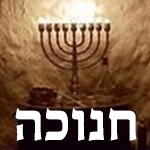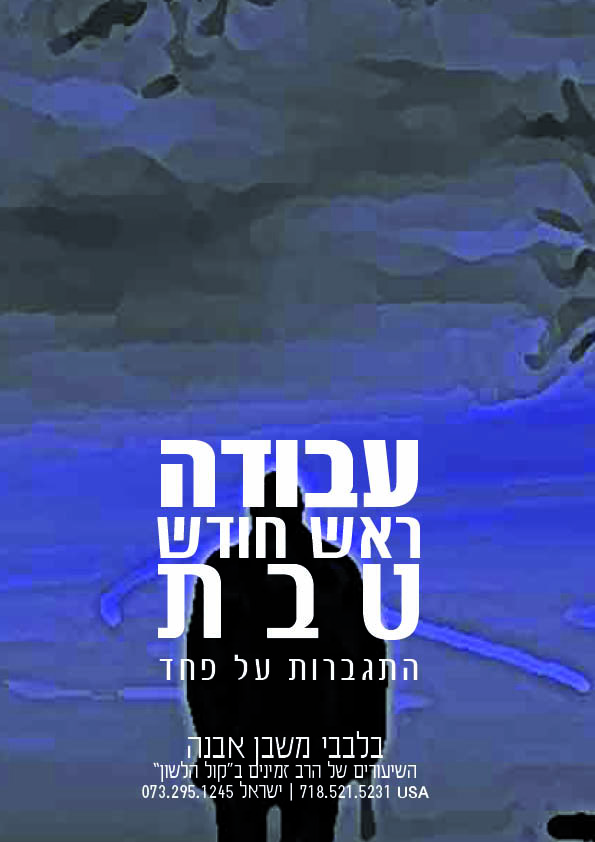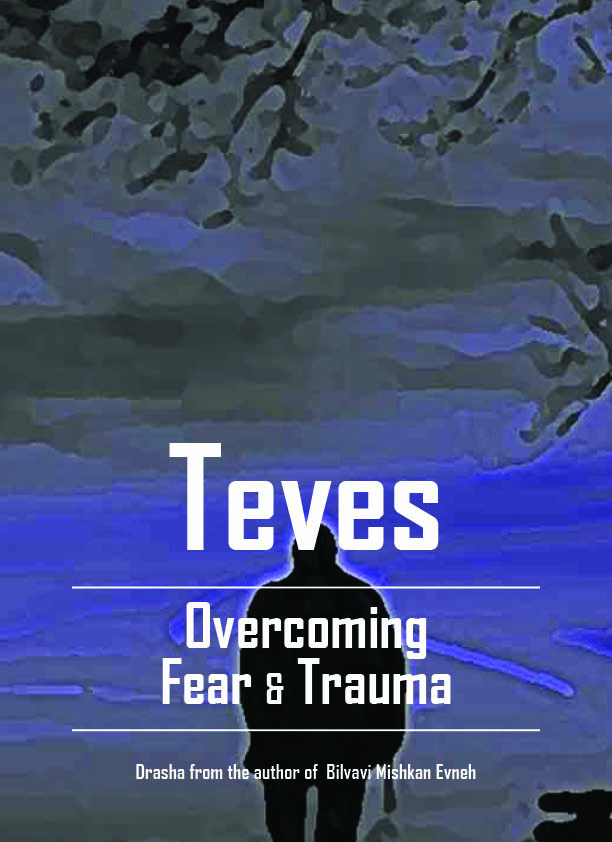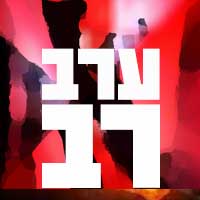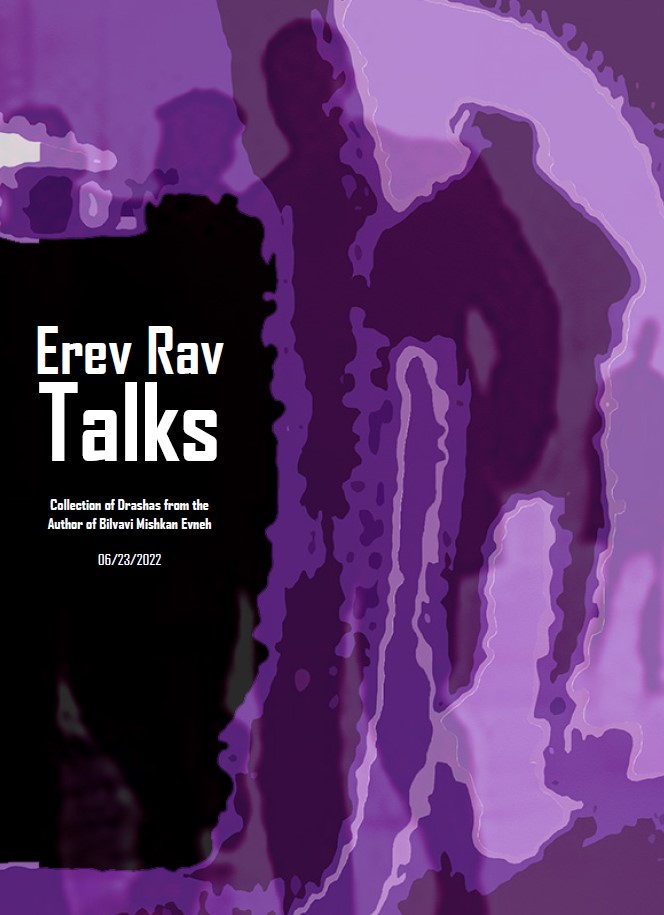- להאזנה סוכות 008 עבודה של הכרת האני בסוכות תשסח
008 The Jews New Perspective
- להאזנה סוכות 008 עבודה של הכרת האני בסוכות תשסח
Succos - 008 The Jews New Perspective
- 11335 reads
- Printer-friendly version
- שלח דף במייל
Be Ready To Acquire A Whole New Perspective
In the previous chapter, we began to describe how we have two layers to our self - our outer, superficial layers and our inner layer. The inner layer of our self is very hidden from us, and we must reveal it. We will now explain how we can reveal it.
Before we learn about how we can reveal something, we first need to know what it is that we are trying to reveal. After we conceptualize something, we can then attempt to reveal it.
When a Jew reflects about what he’s missing in life, he likely thinks that he is missing certain good deeds and that he is lacking knowledge. If this is his approach, he thinks that it is his job to improve how he acts, and to add onto his knowledge. This is commendable, of course, but it won’t help the person leave superficiality. He is still not improving his actual perception; he remains trapped in his limited perspective. Even if he improves how he acts, he never leaves his superficial perception of things. What a person really needs to do is to leave his perspective entirely and dig deeper into himself, where he can uncover a different and deeper perspective in how he views everything in life.
Each of us is searching to have a bond with Hashem. “My soul thirsts for G-d, for the living Almighty.” We all are trying to get there, and we all want it badly. But we need to first have a basic understanding of what it is that we should be wanting and searching for in the first place.
The Inner Point Of Our Self Cannot Be Described
We want to feel Hashem’s existence in our heart. As we explained in the previous chapter, the name of Havayah represents the actual reality of Hashem, while the name of Adonoy (or Adnus) represents our relation to Him in performing the mitzvos. We also explained that the way to reach the reality of Hashem is through self-recognition – we can recognize Hashem from within ourselves.
What we need to know now is how we can come to perceive ourselves as havayah – to recognize our actual existence.
It is really impossible to define havayah. Let us explain why. If something can be understood, but it is very hard to grasp, we can give parables that help us describe what it is. But if there is a point which cannot be grasped at all, there is no way to try to explain it. For example, it is impossible to describe what an angel looks like. All we know about the angels is that our human senses cannot grasp them at all. Although we find that the angels are described sometimes as “light” and “fire”, this still does not help us understand at all what an angel looks like. We aren’t able to imagine them either.
The point is that if something is found in a different dimension than the one we are in, it is impossible to even try to describe it. That is why spiritual concepts cannot be described.
Man’s Perception Is A Fantasy
Getting back to our discussion, we will begin with the following simple reflection. Look at the table and chair in front of you. It seems that we perceive what these objects are: They were made by a certain company, and we can do things with them like sit and eat on them. This is true. But can our senses feel the actual essence of a table or chair? If you think about it, the answer is a simple No.
There are six directions of our physical dimension (north, south, east, west, up, and down), and whenever we see an object, we are only seeing it as it moves among the directions. But we never see an actual object itself!
If someone doesn’t reflect into this concept, he will regard this is philosophy. He cannot accept this, because he is unable to change his immature perspective from his youth, which seems to show us that an object is as it appears.
The truth is that we do not really perceive anything on this world! In the future we will express, “We were like dreamers.” This current world will seem to us like a dream. When you’re in a dream, nothing is real, even though you are seeing things.
Man is called adam, which comes from the word dimayon, imagination. This implies that man’s entire perception is seen through the lens of imagination – we never really see something as it really is.
What results from this is that we have no understanding of the Creator, and nor do we understand the essence of people that we see. All we can grasp about anything is that we see movements going on, but we never truly grasp and sense what another entity is.
Seeing Is Not Believing
We cannot sense the existence of anything as long as we confined to using our human senses. A person who needs to sense something through using any of his five senses will not be able to understand the existence of something, the havayah of something.
A person might think that he needs to find the Creator, but he isn’t aware that first he needs to reveal havayah. A person, before anything, must reveal the simple reality of this world!
There are a few individuals on this world who already grasp the true reality, because they have already revealed Hashem’s existence in themselves. These rare individuals, they have a special avodah of beginning from the ladder up and radiating that light downwards onto this earth. But generally speaking, our avodah is to work our way upwards, beginning from the bottom point – recognizing reality – and then working our way up to the uppermost point, which is to fully recognize the Creator.
This point must be very well understood: we do not see reality! We see movements of reality, but reality itself cannot be felt by any of the five senses.
The Secret
Recognizing reality – hakaras hametzius – is also known as “Toras HaSod”, the “Secret Parts of Torah.” People think that this is referring to learning the Zohar, the writings of the Arizal, the writings of the Reshash, etc. and seek to hear shiurim on these holy writings. But the truth is that if these secrets ever get taught, they are never understood, because a secret cannot be taught! A secret is a heart matter; it cannot be expressed to another person. The only way a person can do a heart transplant to another person is if he’s dead.
A secret is when a person grasps the true essence of something. If something can be seen with the human eye, you can try to explain it to another and help another person conceptualize it. But if something cannot be seen, there is no way to explain it to another. The secrets of Torah, Toras HaSod, are not a kind of knowledge that our intellect can process.
Even if a person knows the entire Zohar and writings of the Arizal by heart – backwards and forwards – it’s possible that he never even grasped even one of its secrets! And the truth is that there is only one secret, not many secrets. The only secret there is to know what true reality is.
When a person hears this, he might ask, “Who doesn’t know reality?!” But there is almost no one who truly knows what reality is! The true reality is hidden from us, no less hidden than how much the Creator is hidden from us. The Torah is a part of Hashem, so to speak; it is reality. Hashem looked into it to create the universe. In other words, Hashem created the world as a havayah – an existing reality – while we only see it through the lens of adnus, the lower perspective. Thus, the actual havayah\existence of the world is really very hidden from us.
Wearing Your Soul’s Garments And Removing Them
We have explained what the problem is: we do not see true reality. Now we will enter more inward into the path we are describing. The path we are describing known as the perspective of “levush”, “garments” – to see everything as garments that cover over a deeper layer.
We all know that in the winter, we more clothing, while in the summer we wear less layers of clothing. This parable helps us understand our own soul: in our own soul, sometimes we wear garments, and sometimes we need to remove our garments. We wear our garments through keeping the Torah and mitzvos, as we are commanded to. There are five garments – action, speech, thought, emotion and will. This is one side of the coin.
The other side of our avodah is that we “remove” our garments. We can understand this with the following parable: When a person gets a gift, sometimes it comes wrapped, and he has to unwrap all the layers until he gets to the gift inside. The lesson is: We were born with many wrappers on us! Our essence is covered over by many “wrappings.” When a gift is given without giftwrap, it’s not befitting. When it remains inside its wrapper though because the person never open it, it’s even worse – he never gets the gift at all. This shows us that it is necessary both to wrap a gift, as well as to unwrap it.
The same can be said of our soul. Our soul contains five garments which we were born with. Sometimes we need to use them, and sometimes we need to remove them. If a person remains his entire life only using his garments and never removing them at times, even if he only uses the garments for holy reasons, he has spent his whole life immersed in garments, and he never reached his true self. It’s like a precious gift that remains unopened, still in its wrapping paper. Even if the “wrapping paper” is very nice, it has to be opened at some point!
Sometimes we have to perform with our garments and make use of them, and sometimes we have to take a break from them.
Detaching Sometimes From Our Soul’s Garments
“For six days you shall labor, and on the seventh day you shall rest.” We know that there is a concept in the Torah of resting from physical action, but the same is true with regards to our deeper soul garments – speech, thought, emotion and will. Sometimes, we need to detach from these as well.
Just as physical action is viewed by us as an action, so is speech a kind of action. On Shabbos, we refrain from talking about weekday activities, so we have a concept of rest from speech as well.
Our emotions as well need to be silenced and withheld sometimes. We cannot always acts merciful, for example, like when it comes to having mercy on a cruel person, which is forbidden. Shaul was punished for having mercy on Agag, the king of Amalek, and for being cruel to the city of Nov when he should have spared them. Sometimes a person has to act humble, and sometimes he has to be haughty (and the Baal Shem Tov explained that this is when views his haughtiness as a “garment” that he has to put on, which he can remove afterwards). There are other examples as well brought in Chazal as well in which we must detach from emotions.
Our thoughts also need to be silenced sometimes. We usually need to think, but sometimes we must stop our thoughts, like to refrain from thinking about Torah during davening or on Tisha B’Av.
Our ratzon also has to silenced sometimes, because there are some desires we have which we need to get rid of, and there are some desires which we need to put on hold and return to them later.
The Art of Detachment: The Secret of Reaching Our Essence
What is so terrible if a person never learns how to detach from his soul garments? As long as he performs holy actions his whole life, why should it bother him if he can’t detach sometimes?
On one hand, it is commendable if a person is always in any of his soul garments for holiness. But on the other hand, by always being involved in the garments, he never comes to recognize his essence, and he only knows of his garments.
If a person really wants to recognize himself, he needs two things. On one hand, he must adhere to the entire Torah and mitzvos; he must wear his garments as much as he is commanded to according to the Torah. But a person also has to learn to remove his garments sometimes, when the time calls for it – as long as it is within the guidelines of Torah.
Just as the Kohen Gadol would constantly go through a cycle on Yom Kippur of getting dressed, undressing, and getting dressed again, so is there a time and place for “wearing” our soul garments and for “removing” our soul garments. A person who knows when to use his abilities, and when to detach from them, is someone who will be able to reach his essence. If someone only knows how to use his soul abilities but he doesn’t know how to detach sometimes from them, he won’t be able to reach his essence.
One of the Sages said, “Just as I will receive reward for speaking, so will I receive reward for abstaining [from speech].”[1] We know what the reward is for doing the mitzvos; “the reward of a mitzvah is a mitzvah.” But what is the concept of abstaining from actions, and what is its reward? The reward is: that the person merits to attain true teshuvah (to repent), by meriting a revelation of his true self – the soul in its pure form, with no garments attached. That is his reward. The Sages say that “There is no reward on this world”[2], and the reason for this is because the true reward is to merit a soul that has no garments attached; on this world, there is no such reward, because all of the 613 mitzvos we do on this world are garments.
If a person merits to be one of the special individuals who reveals his essence already on this world, he is living the Next World already on this world. It resembles the state of Adam before the sin. The word mitzvah comes from the word “tzavta”, “companion” – hinting to the reward for a mitzvah, which is that a person merits companionship with the Creator.
Utilizing Both Speech and Silence To Reach The Self
As a person lives on this world, sometimes he has to wear his soul garments, and sometimes he needs to take them off, and therefore it is impossible for one to constantly be in a state in which is inner self is revealed. The mitzvos of the Torah require us to make use of our soul garments; this is one side of how we reveal Hashem, and it reflects our avodah of adnus, to relate to Hashem as our Master as we carry out all His commandments.
But the other side to our Avodah is to relate to Him with His name of havayah, and this reflects how the Kohen Gadol on Yom Kippur would pronounce the name of havayah (as well as how the Kohanim would pronounce it every day when they blessed the congregation in the Beis HaMikdash). Every person, in his own soul, has this power of the Kohen Gadol to “pronounce the name of havayah”, in which Hashem can be revealed to him, with no garments coming in between.
Let us now summarize this concept in clear and simple words: On one hand, we need to reveal the outer parts to our self, which are our actions, speech, thoughts, emotions and will. We need to find where we mostly identify our “I” with amongst these five layers to our personality. Simultaneously, we must also find our actual essence.
In order to reach the inner self, a person has to set aside time of the day in which he can reach his essence, by removing the layers of his soul. This is the secret behind the avodah known as “hisbodedus” (Jewish meditation).
There are people who try to practice meditation as a way to reach their inner self, but they think that hisbodedus is about speaking the entire time with Hashem. Even when they do attain quiet, it’s only because they run out of patience to speak with Hashem so much. They feel that every word spoken to Hashem during hisbodedus is precious, and therefore they opt to talk to Hashem the whole time. This is certainly truth to this point, but the problem is that when people only talk to Hashem during their time of hisbodedus, they actually lose their connection with Hashem in the process, because they are still involved with their self.
A bond with Hashem is not dependent on talking with Him. If a person was born as a mute, does he have no chance of becoming close to Hashem, since he can’t talk?! Of course not. In fact, a mute can probably form an even deeper kind of connection with Hashem, a more direct connection, since he doesn’t need the “garment” of talking to get to Him – he achieves it by forming an internal kind of connection with Him.
During the time of hisbodedus, a person needs to form a relationship with Hashem both through talking to Him as well as through learning how to be silent.
Silencing Your Garments
On one side of the coin, a person has to form a bond with Hashem through developing his motivations and maturing in his service towards Him. Simultaneously, a person also needs to learn how to negate his very will. During the time of hisbodedus, a person needs to increase his will for holiness, to think holy thoughts and to have holy feelings, as well as to increase holy speech and accepting upon himself to better his actions. This is one side of the action – improving the garments of the soul.
The inner side to hisbodedus is that a person needs to reach a point of silence. He should reach a state in which he doesn’t do anything at all. He should also silence himself from any talking, and then calm his thoughts, emotions, and finally, his desires.
If a person succeeds in calming all of these layers, he will begin to feel his essence. Even if a person can’t silence all five layers at once (action, speech, thought, emotion, and will), he can still begin to feel his inner self a little more with the more he silences some of the layers.
When a person totally silences all of these layers, he can come to reach a full revelation of his inner self. In order to fully reach the inner self, all five layers need to be silenced, and a partial inner silence won’t suffice. The full revelation of the self can only be experienced when there is a total inner silence – when the actions, speech, emotions, thoughts, and will have all been quieted down.
It is difficult for a person to reach a total silence of all his five soul layers, and therefore we all understand that it can take a long time. “The years of a man are seventy, and if he is strong, eighty years.” Hashem gave us an average lifespan of 70-80 years specifically because He knew it would take us so long to get to our inner self! It can be called the “tractate” of our life. If a person doesn’t reach a total inner silence and he only reaches a partial inner silence, he will still feel his inner self a bit, but it won’t be nearly as strong as someone who has the complete inner silence.
This is the second stage in reaching one’s inner self – by silencing the five garments of the soul: action, speech, thought, emotion, and will.
Only Jews Can Integrate These Two Abilities of Mankind
It is told of Reb Nachman of Bresslov that all the Torah which had been revealed to him was very novel, but whatever he didn’t know was even more novel.
Many people toiled to try to understand this statement. The inner meaning of it is as follows.
Usually, we think that all we have to do is to do the mitzvos and not do the aveiros. This is true, but it is only one side of the coin. The other side of the coin is that we must learn how to reach an absolute inner silence; just like we must develop our five soul garments, so must we be able to silence them.
A Sukkah contains it both light (ohr) and shadow (tzeil). The shadow must not be bigger than the amount of sunlight in the Sukkah[3], but the Sukkah still must have some of both. This shows us that we need to integrate both our “light” and “shadow” together – we need to make use of our soul abilities, as well as to detach sometimes from our soul abilities.
Chazal say that in the future, the non-Jews will request reward, so Hashem will make a condition with them that if they keep one easy mitzvah, the mitzvah of Sukkah, they will receive reward. The non-Jews will agree and they will go to sit in the Sukkah, but Hashem will make it hot on Sukkos, and they will get too uncomfortable and leave the Sukkah, kicking it down on the way out.
The depth behind this matter is that a non-Jew cannot integrate the dual nature of mankind together; they can understand that they need to do one or the other, but to incorporate both elements together is beyond them. For example, there are non-Jews who are very kind-hearted, and they feel that life is about loving and caring for others. There are non-Jews who are very generous, who give millions of dollars to charity. There other non-Jews who also understand the need to be in solitude and get in touch with the inner self, and to feel that there is nothing in existence except for God.
Either of these non-Jewish groups are halfway correct. We have to be nice and care about others, and we also have to reach our inner self through solitude and come to recognize the Creator. But what a non-Jew cannot understand is that a person needs to do both. He must exemplify a benevolent being who helps others, as well as be in touch with his inner self. A non-Jew will understand either one of these facts about life, but he cannot incorporate both into his life simultaneously. A Jew has the power to integrate them both together.
Integrating The Dual Natures Together
We will explain more about how to integrate these dual natures of mankind.
We will use the following scenario to illustrate the concept at hand. What does it mean to “integrate” two different entities together?
Let’s say a person has twins, and he buys a double stroller to hold both of the babies. When he’s wheeling them around in the double stroller, are the two babies ‘integrated’ together? No, because are they are rather viewed as two babies in the same carriage. So this is not a good example of what it means to ‘integrate.’
What about a person who works, and he decides he will now start to do chessed? He splits his schedule so that he will have a few hours a day in which he works, and a few hours in which he does chessed. Does this mean that he is integrating his personal life with helping others? He’s simply rearranging his schedule. Although he has integrated more people into his life by giving more of his time to help them, he’s not simultaneously integrating others with his job, because he has different times for each of these activities.
An inner kind of integrating is when a person can simultaneously accomplish two different activities. We have begun to explain that on Sukkos, we have two mitzvos – the mitzvah of sitting in the Sukkah, the mitzvah of shaking the Four Species. The fact that we have these two mitzvos shows us that it is our avodah to integrate our two aspects in how we relate to Hashem – our lower aspect, adnus (reflected by how we must perform the mitzvos) and our higher aspect, havayah (our recognition of Hashem).
What does this mean? Does this mean that we split up Sukkos into two activities – part of the day we sit in the Sukkah, and part of the day we take the Four Species? That is only a superficial approach. The real definition of our avodah on Sukkos is to integrate the Four Species with the Sukkah - in other words, to perform the mitzvos upon a recognition of His existence.
As we explained before, there are non-Jews who understand what the concept of havayah is, and there are also non-Jews who understand that life is about performing actions to benefit others, but a non-Jew cannot integrate both systems at once in his life. Only a Jew knows how to come to perform properly based upon the recognition of Hashem’s existence – a Jew can know how to connect these two pieces of knowledge together and see how they integrate.
Connecting To The Depth of Reality Even Amongst The Realm of Action
“The purpose of knowing about You [Hashem] is to realize that we do not know of You; however, all we can know is that You exist, and that is all that we can arrive at with our mental capabilities.”[4] Our actions on this world must be connected to the havayah, the true reality. If not, then a person is only connected with Hashem when he has time for hisbodedus, but when he goes out in the world and takes care of his various chores, he disconnects totally from havayah. He views havayah and this world of action as two separate worlds that cannot be integrated. But if a person learns how to integrate havayah into his daily actions, and vice versa, then he achieves a constant connection with the Creator.
A story is told about the philosopher Aristotle, who was once seen indulging on a plate of food. A student passed by and asked him, “Isn’t it unbefitting for the great philosopher Aristotle to indulge on food like this?” Whereupon the philosopher responded, “When I eat, I am not Aristotle.” This is an example of an identity crisis – when someone cannot incorporate his wisdom into his daily life. He viewed his wisdom as one thing, and his actions as a separate thing, and he did not see how they must become integrated.
The entire lesson of our holy Torah, the secret of our entire life’s work in our service towards Hashem, is about revealing the reality of Hashem in all situations. “There is no place that is empty from Him.” We need to reveal Hashem’s existence, but not only that – we need to incorporate His existence into the way we act. We must reveal Hashem through our own private hisbodedus, when we detach from our soul layers, as we explained. And along with this, we need to reveal Him also during the times of the day in which we are actively using our soul garments. The reality of Hashem’s existence must become manifested in how we act throughout the day.
Why It Is Difficult For People To Enter Inward
When we understand this, we can now understand another thing: why most people have a hard time entering inward, even though they are really yearning to do so. People have honest and true aspirations for holiness; why are many people not succeeding in getting there? It is because there is a great lack of understanding about what pnimiyus (“inwardness”) is and how to enter it.
One reason for this is because we are found in a world of action, and we are not yet in touch with the deeper meaning to reality, havayah. The second reason why people don’t enter the inner world is because people don’t understand that the inner meaning of reality is something that can become manifest in how we act throughout the day as well.
Chazal say that in the future, the mitzvos will disappear.[5] There are many explanations of this statement; the following explanation is the one that pertains to our discussion. The depth of this statement is that the mitzvos are only secondary to the inner meaning of reality, havayah, and in the future when havayah is totally revealed, the mitzvos will only be viewed as a spark of reality, and it will pale in comparison to the radiating light of havayah.
According to this explanation, it is not the actual mitzvos which will disappear in the future, but rather, a change of perspective. In our current state we view [initially] view mitzvos as actions to perform, and in the future, each mitzvah will appear to us a spark of reality. A Lulav will not just be an action we perform, but a spark of the great reality that has been revealed.
There is only one reality – Hashem, who is “One, and His Name is One.” Everything that we see on this world are only sparks of that one, single reality – which shines itself onto every place in Creation in many forms.
When we look around at the world, we see many people, and it appears that there is more than one reality going on. But through revealing the perspective of havayah, a person is able to view all the disparities as being many sparks that make up one single unit – the reality of the Creator. Nothing is apart from the reality of the Creator. “There is no place that is empty from Him.”
We live in a time of hester panim (concealment of Hashem’s radiance), we also have to view it with this perspective, that all hester panim is essentially a lack of understanding of reality. There is no such thing as becoming apart from the Creator.
In Summary: Moving From The “I” To The Creator
To summarize: In order for a person to truly recognize the Creator, to truly recognize the reality that exists, one first needs to understand what his own reality is. He must realize that whatever he has understood about himself until now was only a superficial sense of self-recognition, based on his senses and mind, which can only grasp movements of reality, not reality itself.
By detaching oneself from the five garments of the soul, one can recognize his essence, and from that, he can come to recognize the Creator. He can then deepen this recognition even further and reach an even higher point, which is to realize that there is really one true “I” that exists – the Creator, for there is nothing else besides Him.
So first, a person has to realize what he isn’t. Then he can understand who he really is, and then he can recognize the Creator. The final stage is to recognize that there is only One “I” – the Creator; for all of Creation are merely emanations and sparks of His existence.
NOTE: Final english versions are only found in the Rav's printed seforim »


